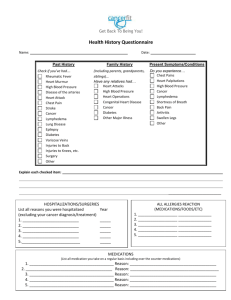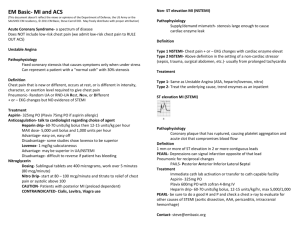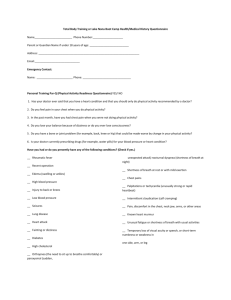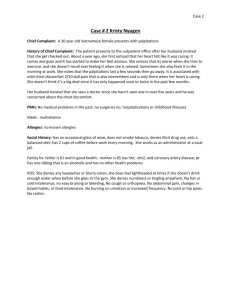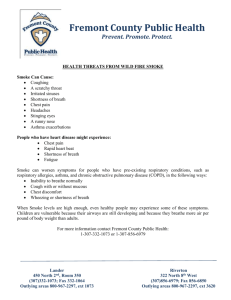PE Part 1 Show Notes (Word Format)
advertisement
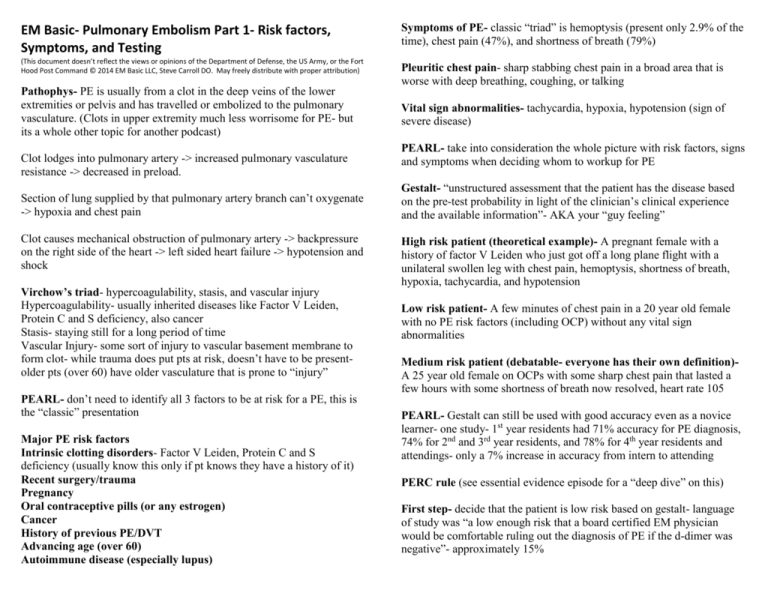
EM Basic- Pulmonary Embolism Part 1- Risk factors, Symptoms, and Testing (This document doesn’t reflect the views or opinions of the Department of Defense, the US Army, or the Fort Hood Post Command © 2014 EM Basic LLC, Steve Carroll DO. May freely distribute with proper attribution) Pathophys- PE is usually from a clot in the deep veins of the lower extremities or pelvis and has travelled or embolized to the pulmonary vasculature. (Clots in upper extremity much less worrisome for PE- but its a whole other topic for another podcast) Clot lodges into pulmonary artery -> increased pulmonary vasculature resistance -> decreased in preload. Section of lung supplied by that pulmonary artery branch can’t oxygenate -> hypoxia and chest pain Clot causes mechanical obstruction of pulmonary artery -> backpressure on the right side of the heart -> left sided heart failure -> hypotension and shock Virchow’s triad- hypercoagulability, stasis, and vascular injury Hypercoagulability- usually inherited diseases like Factor V Leiden, Protein C and S deficiency, also cancer Stasis- staying still for a long period of time Vascular Injury- some sort of injury to vascular basement membrane to form clot- while trauma does put pts at risk, doesn’t have to be presentolder pts (over 60) have older vasculature that is prone to “injury” PEARL- don’t need to identify all 3 factors to be at risk for a PE, this is the “classic” presentation Major PE risk factors Intrinsic clotting disorders- Factor V Leiden, Protein C and S deficiency (usually know this only if pt knows they have a history of it) Recent surgery/trauma Pregnancy Oral contraceptive pills (or any estrogen) Cancer History of previous PE/DVT Advancing age (over 60) Autoimmune disease (especially lupus) Symptoms of PE- classic “triad” is hemoptysis (present only 2.9% of the time), chest pain (47%), and shortness of breath (79%) Pleuritic chest pain- sharp stabbing chest pain in a broad area that is worse with deep breathing, coughing, or talking Vital sign abnormalities- tachycardia, hypoxia, hypotension (sign of severe disease) PEARL- take into consideration the whole picture with risk factors, signs and symptoms when deciding whom to workup for PE Gestalt- “unstructured assessment that the patient has the disease based on the pre-test probability in light of the clinician’s clinical experience and the available information”- AKA your “guy feeling” High risk patient (theoretical example)- A pregnant female with a history of factor V Leiden who just got off a long plane flight with a unilateral swollen leg with chest pain, hemoptysis, shortness of breath, hypoxia, tachycardia, and hypotension Low risk patient- A few minutes of chest pain in a 20 year old female with no PE risk factors (including OCP) without any vital sign abnormalities Medium risk patient (debatable- everyone has their own definition)A 25 year old female on OCPs with some sharp chest pain that lasted a few hours with some shortness of breath now resolved, heart rate 105 PEARL- Gestalt can still be used with good accuracy even as a novice learner- one study- 1st year residents had 71% accuracy for PE diagnosis, 74% for 2nd and 3rd year residents, and 78% for 4th year residents and attendings- only a 7% increase in accuracy from intern to attending PERC rule (see essential evidence episode for a “deep dive” on this) First step- decide that the patient is low risk based on gestalt- language of study was “a low enough risk that a board certified EM physician would be comfortable ruling out the diagnosis of PE if the d-dimer was negative”- approximately 15% If medium or high risk- proceed immediately to advanced imagning (CT or V/Q) Coags- not very useful but often included on chest pain workup setsmost people want a baseline before anticoagulation but they probably won’t be abnormal unless patient on warfarin AKA Coumadin If low risk by gestalt- apply the PERC rule HCG- in all females of child bearing age Mnemonic- BREATHS Blood in the sputum (hemoptysis) Room air sat less than 95% Estrogen use (OCPs or other estrogens) Age greater than 50 Thrombosis- either a PE/DVT in the past or current suspicion of a DVT Surgery or trauma in the past 4 weeks If all negative- stop the workup for PE- risk of PE is 1.6%, risk of harms from testing and treatment of DVT 1.8%- will cause more harm than benefit if you test these patients Troponin- useful for risk stratifying patients with PE once it is diagnosed HOWEVER- not everyone agrees with testing all patients with troponin right off the bat- if your CT is negative then you are now stuck with only one troponin- some will argue that “one set is no set” and you have to trend troponins to be sure this isn’t ACS/MI. However, if you explain in your chart that you don’t think this is ACS/MI, you are on ok medicolegal ground. Wouldn’t recommend novice learners suggest this right off the bat but be prepared to justify your decision to order/not order If any of those criteria are positive- do a D-dimer If D-dimer is negative- stop the workup for PE If D-dimer is positive- get advanced imaging D-dimer- measures the degradation products of cross-linked fibrin- don’t order this without using a clinical decision rule first! Only for low risk patients! Very sensitive for PE (95%) but false positives as high as 5070%- causes a lot of unnecessary testing if ordered indiscriminately. Ddimer also increases with pregnancy to the point where it really isn’t useful Other decision rules- Well’s, Revised Geneva- not as commonly used Advanced imaging Workup for PE (after using a clinical decision rule) CT Pulmonary Angiogram- CTPA or CTA for short Chest x-ray- most patients have chest pain/shortness of breath- look for other causes like pneumothorax, pneumonia, pleural effusion, lung mass, etc. -Quick and easy to obtain in most EDs, very accurate and reveals other possible diagnoses that could cause chest pain/shortness of breath EKG- looking for signs of cardiac ischemia, signs of MI- “classic” S1Q3T3 sign only about 20% sensitive Labs CBC- look for anemia as cause of chest pain, elevated WBC (infectious causes, low yield), low platelets (if PE found prior to anti-coagulation) -Limitations- patients with renal failure, patient exceeds the weight limit of the CT table, pregnancy (relative limitation- see below) V/Q scan- IV radioactive tracer is injected to examine pulmonary vasculature followed by inhaling a radioactive tracer, if a lung segment ventilates but does not perfuse, it suggests a PE -Limitations- much less accurate than CT, does not reveal alternate diagnoses, Chest x-ray needs to be completely clear for it to be useful Chem Panel- Check creatinine for IV contrast for CTA -Only useful if the test is read as completely negative/normal- a “low probability” of PE still has a risk of PE of 20% (way too high) Bilateral lower extremity ultrasounds- in a patient with signs and/or symptoms suggestive of PE, a clot in the legs pretty much equals a clot in the lungs- however, if negative it’s not helpful at all- can be used in pregnancy as an option but usually prefer better confirmation in form of CT or V/Q scan Advanced Imagining for PE in Pregnancy CTA -PROS- in pregnancy, even one abdominal CT is still below known threshold of harm for radiation for the fetus so radiation should not be a concern, can adjust CT scanner settings to avoid scanning into the abdomen -CONS- concern over radiation exposure, more non-diagnostic CT scans in pregnancy due to physiologic changes (changes in blood volumes and cardiac output), ? harms of contrast exposure in pregnancy for fetus (not proven in literature but likely never to get a good answer on this) V/Q scan -PROS- if chest x-ray is normal then higher rate of diagnostic scans compared to CT, much less radiation exposure -CONS- not as accurate as CT, radioactive tracer concentrates in the bladder which is right next to the uterus (can have patient urinate immediately after scan to reduce radiation exposure) PEARL- follow your institution’s guidelines in regards to choice of test and consenting patients for PE imaging in pregnancy . Go through the pros and cons of whatever imaging you choose and have the patient sign a consent form after a frank discussion of all the risks and benefits PEARL- PE is a serious disease in pregnancy- you can’t not pursue the diagnosis because the workup may be difficult Contact- steve@embasic.org Twitter- @embasic

